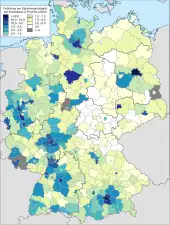| Total population | |
|---|---|
| 3,900,000 Irish trips to Continental Europe in 2006. 70 million Irish 1st and 2nd Generation live abroad, 4% in Continental Europe, equates to 2.8 million Irish people in Continental Europe(Central Statistics Office (Ireland).) | |
| Regions with significant populations | |
| All over continental Europe, particularly France and Spain | |
| Languages | |
| English, Irish | |
| Religion | |
| Christian (Roman Catholicism, Protestantism), Atheism | |
| Related ethnic groups | |
| Irish people, Overseas Irish |
Irish people in mainland Europe are members of the Irish diaspora who reside in mainland Europe.
Demographics
While the Irish population in Continental Europe is about 450,000-550,000, it was estimated that there are 2.8 million first, second, and third-generation Irish living there. There are an estimated 5 million people with active interests in Irish music, Irish sports, Irish dancing, Irish culture and Irish literature. For example, Poland's Irish Embassy has confirmed that while there are approximately 500 Irish residents in the country, there are between 50,000 and 100,000 people involved in the Irish music, dancing and cultural scene. Italy, with an estimated Irish population of 2,000 to 5,000, has a website receiving 100,000 regular visitors, mostly covering Irish music and culture in Italy. Similar levels of interest in Irish culture exist all over Europe.
Western and Central Europe
Central Europe
Irish presence in Central Europe dates back to the Middle Ages, when Irish monks established several monasteries, including the Schottenstift in Vienna in 1155.[1]
There were 1,830 and 257 Irish people in Poland and Slovakia, respectively, according to the 2011 Polish census and 2021 Slovak census.[2][3]
France
30,000 Irish live in France, including more than 15,000 in Paris.[4]
Germany

Irish presence in Germany dates back to the Middle Ages, as by the turn of the 13th century Irish Benedictines established monasteries in Regensburg, Würzburg, Constance, Erfurt and Nuremberg, and several priories.[5]
Over 2,800 people moved to Germany from Ireland in 2012, including almost 800 German citizens.[6] As of 2021, about 35,000 Irish live in Germany.[7] Together with Germans interested in Irish culture, some of these emigrants organise Irish cultural events across the country.
Low Countries
Eastern Europe
6,000 Irish live in Eastern Europe: Armenia, Azerbaijan, Cyprus, Belarus, Bulgaria, Georgia, Greece, Kazakhstan, Moldova, North Macedonia, Romania, Russia, Turkey, and Ukraine. Irish culture, Music and Dancing is growing in Russia and Nations which were part of the former USSR. There's Irish dancing in Cyprus, Ukraine, Russia, Turkey, Greece, and Bulgaria. Many of the more than 125 Irish bars have regular live Irish music, as well as live Irish sports coverage - GAA, soccer, and rugby. Irish singers and European-based Irish music groups tour here regularly, as do Irish dance shows. There are Irish societies in Cyprus, Russia, Greece, and Belarus, promoting cultural and social links between the host country and Ireland. Locally based Irish regularly support visiting Irish sports, both men's and women's, such as Irish boxing, Irish golf, motor rally, rowing, association football, walking and athletics, rugby, cycling and show jumping teams, which were all in this region this year. Irish charity groups and defence forces also have centers and commitments based in the region.
Gallery
<gallery> File:Convent of St Gall.jpg|thumb|right|150px|Abbey Convent of St. Gall, located in the Swiss city with the same name, was founded by the Irish Benedictine monks. File:Ludovisi - S. Isidoro.jpg|thumb|upright|Chiesa di Sant'Isidoro a Capo le Case is the National Church of Ireland in Rome.
References
- ↑ Parsons, Nicholas (2009). Vienna: A Cultural History. Oxford University Press. p. 103. ISBN 978-0-19-537606-7.
- ↑ Ludność. Stan i struktura demograficzno-społeczna. Narodowy Spis Powszechny Ludności i Mieszkań 2011 (PDF) (in Polish). Warszawa: Główny Urząd Statystyczny. 2013. p. 261. ISBN 978-83-7027-521-1.
- ↑ "Ethnic composition of Slovakia 2021" (in Slovak and English). Retrieved 10 January 2024.
- ↑ étrangères, Ministère de l'Europe et des Affaires. "Présentation de d'Irlande". France Diplomatie : : Ministère de l'Europe et des Affaires étrangères. Retrieved 8 February 2019.
- ↑ Majorossy, Judit (1997). "Irish in Central Europe in the Middle Ages. Some Aspects of the Irish Monastic and Literary Activity during the 11th–15th Centuries". International Conference of PhD Students. University of Miskolc, Hungary 11-17 August 1997. Section Proceedings: Humanities. Miskolc. pp. 144–145.
{{cite book}}: CS1 maint: location missing publisher (link) - ↑ "Irish Times". Irish Times.
- ↑ "Irish People in the World".